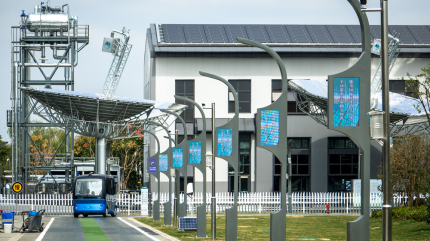
Jiangsu Province, on the east coast of China, is one of the country’s leading provinces in technology and tourism and home to many of the world’s key exporters of electronic equipment, chemicals, and textiles.
Serving Jiangsu is one of the largest provincial power grid companies of the State Grid Corporation of China (SGCC). State Grid Jiangsu[i] serves 46.2 million energy consumers and incorporates State Grid Suzhou Power Supply Company. The Suzhou region is a prefecture-level city with a GDP of over CNY2 trillion, and as a result, Jiangsu faces significant energy consumption with a growing need to balance its economic growth with a reliable and efficient energy supply.
Until recently, State Grid Jiangsu’s power communication networks primarily utilised optical fibres in offices, power supply stations, and 35 kV or higher-voltage substations. Medium-voltage power grids had low coverage and distribution automation services, while power consumption data collection relied on wireless public networks. On the user side, optical cable coverage was low, with insufficient communication capability.
Power systems are currently undergoing a radical digital transformation. This evolution has further increased the demand for intelligent power distribution and consumption networks, and as such, State Grid Jiangsu realised that it urgently needed to build a power communication network that could support these new smart grid services.
A dedicated wireless private network
State Grid Jiangsu is now pioneering a transformative approach to power grid management through the development of an electric power wireless private network that is reshaping how power is generated, distributed, and managed. More than a technical upgrade, this specialised wireless network is creating a more intelligent, interactive, and responsive power grid, transforming traditional energy transmission into a dynamic, two-way system that can adapt to emerging energy demands.
Jing Dongsheng, Deputy Director, Technology and Digitalisation Department, State Grid Suzhou Power Supply Company, says that energy demand, supply constraints, and new low-carbon requirements were putting the province under a lot of pressure. This necessitated a comprehensive, technology-driven approach to the transformation of the power grid to improve its operational safety and power supply service quality.
“State Grid Jiangsu is developing a new electric power system and renewable energy resources,” says Jing. “We’ve connected a lot of new renewable energy systems, including distributed PV power, to the provincial power grid, and changed the traditional power transmission model, so that we can create a bidirectional, interactive, balanced and active power grid.”
State Grid Suzhou now operates the largest electric power wireless private network in China, with 800 base stations providing full private network coverage for the region. The network connects around 90,000 terminals of more than 20 types, including automatic power distribution and power generation-grid-load-storage terminals. Today, Suzhou has the largest wireless private network for the energy sector in terms of scale, coverage, and the number and types of terminals connected. “This network provides the support needed for the digital and intelligent transformation of the power grid,” says Jing.
How is this wireless private network different?
Qi Baozhen is Full-Manager, Technology and Digitalization Department at State Grid Suzhou. He explains: “Electric power wireless private networks that operate on a dedicated spectrum are communication networks customised specifically for power grids.
“They are secure, flexible, and easy to maintain. Power distribution and consumption terminals are distributed widely across complex environments, and this network can provide precise signal coverage for all these terminals, making terminal-based networking and network-cloud interaction a reality.”
This fills the gap in end-to-end independent and controllable communication technologies, streamlining ‘last mile’ operations, and is a key part of data transmission.
“This network connects a huge number of electric power terminals across the grid and enables them to be intelligently, remotely controlled,” continues Qi. “This wasn’t possible with our old wireless public networks, in part because of their weaker security. This network supports more secure, reliable, and resilient grid operations.”
The development of Suzhou’s power grid
Jing explains that the network serves as the digital foundation for Suzhou’s new power system, supporting information collection and data transmission for the huge number of terminals on the grid.
First, the network helps power supply companies improve service quality and efficiency. “It has increased the proportion of remotely controlled terminals on Suzhou’s power grid by nearly 130% and reduced average power outage times by 30%,” says Jing. This has significantly improved the quality of power supply services and helps power supply companies cut costs by reducing the cost of fibre optical cable construction by more than CNY1 billion.
Secondly, the network enables more power from distributed new energy systems to be integrated into the grid. “It has increased the number of distributed PV and other new energy systems connected to the grid by 300%, shortened grid integration and communication access times for distributed PV systems by 95%, reducing the construction cost of new energy power systems by over CNY100 million,” says Jing, boosting the development of new energy systems in Suzhou.
Finally, the network drives the electric power wireless communication industry, enabling the development of wireless private network equipment, such as base stations, core networks, and other upstream and downstream terminals across the industry value chain. “The network has helped increase the annual revenue of Suzhou’s wireless private network industry to more than CNY100 million,” Jing says.
Huawei solutions for Jiangsu
Liao Shaobo is Executive Industry Solution Manager and Wireless Solution Expert, Electric Power Digitalization Business Unit for Huawei, a major supplier for Jiangsu’s wireless network, and has provided the project with secure, reliable, flexible, and efficient end-to-end LTE network products and solutions. This includes communication modules that support both public and private networks and secure, high-capacity core networks.
“We have designed wireless private network solutions for several industries,” says Liao. “Many industry customers from around the world have chosen Huawei as their partner for wireless communication private networks.”
For more details on Huawei’s expertise in wireless communication networks, please click here.
[i] State Grid Jiangsu Electric Power Co., Ltd. (“State Grid Jiangsu”, of which State Grid Suzhou Power Supply Company is a branch)

